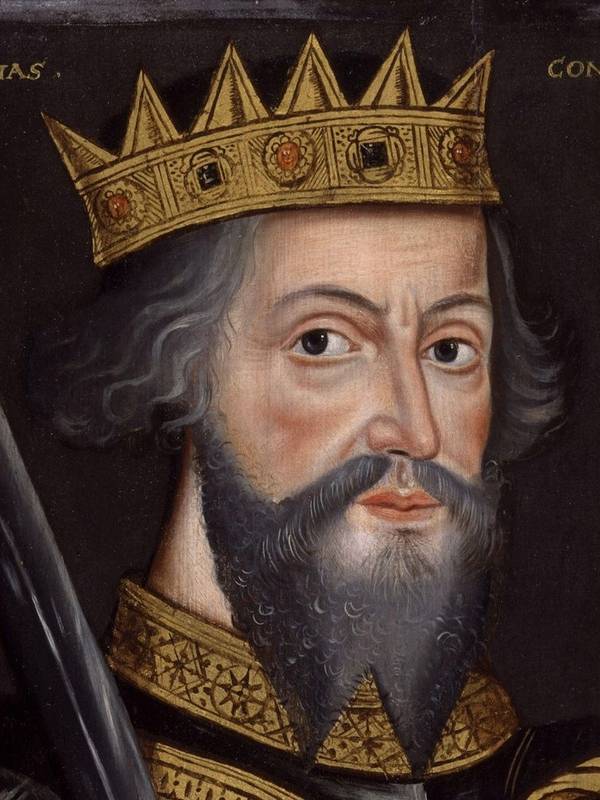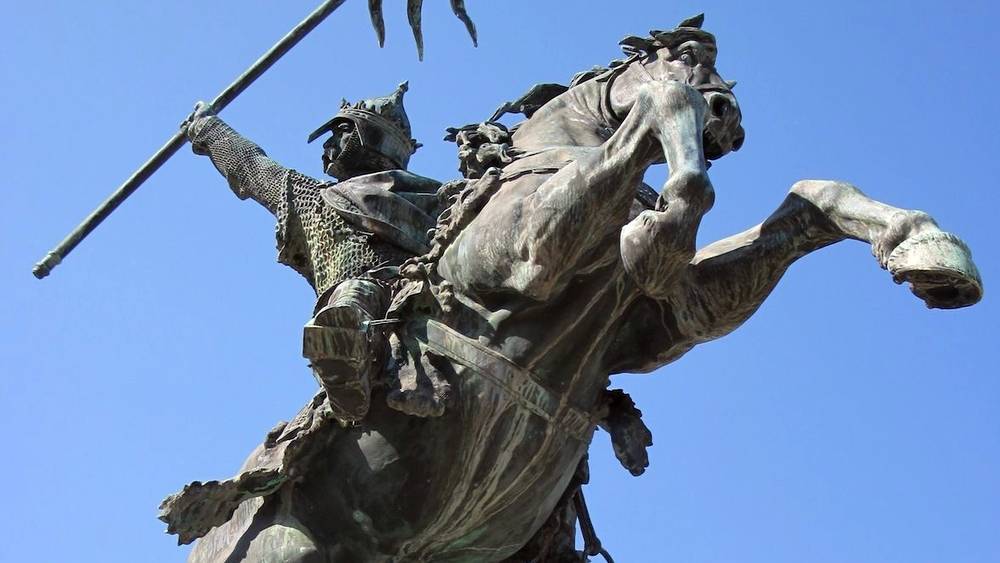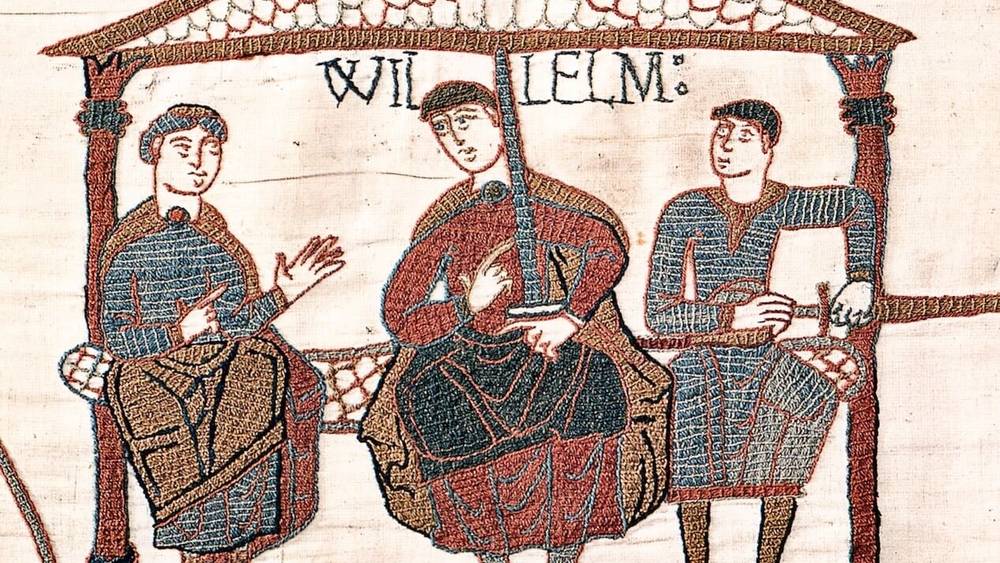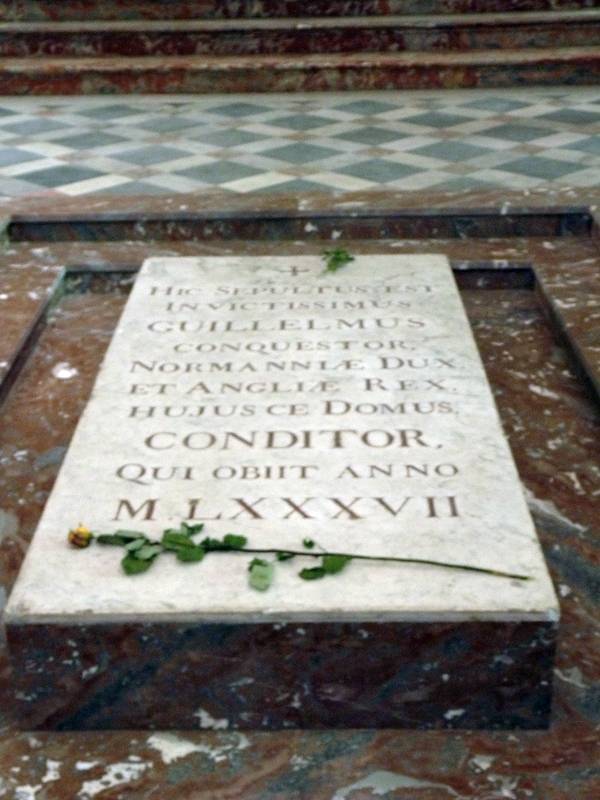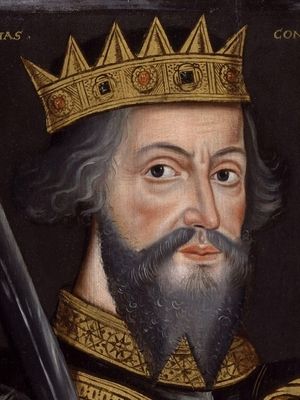
William the Conqueror
First king of Normandy of England, William 1st said "The Conqueror", was born in 1028 at the castle of Falaise, in France. William was the illegitimate son of Robert "the Devil" or "the Magnificent", Duke of Normandy and his mistress Herleve (sometimes called Arlette), the daughter of Fullbert, master of Falaise. Before history named him "the Conqueror," William was better known to his contemporaries under the name of William the Bastard. Herleve would have attracted to him Duke Robert thanks to his capacity of dancer if one believes some narratives.
The Norman dynasty was founded by the ancestor of Robert Rollo or Hrolf the Ganger, a Viking chief, who had received the duchy by Charles the Simple, king of France, in 911, to the treaty of Saint-Clair-sur-Epte, in exchange for his feudal allegiance and his conversion to Christianity, during which he took the name of Robert.
The mother of William the Conqueror, Herleve, also had a daughter, Adelaide, of Duke Robert. Although they had a long relationship, the gap in their social situation made marriage out of the question and Herleve was married to one of Robert's vassals, Herluin, a knight. Herleve had two other sons, Robert, who later became the Earl of Mortain and Odo, destined to become Bishop of Bayeux and Duke of Kent. He later played an important role in the history of England.
William the Conqueror, Duke of Normandy
Duke Robert decided to expiate his sins, which were numerous, thanks to a pilgrimage made in 1034. As he had no legitimate heir to succeed him, he persuaded his unruly barons to accept the illegitimate William Conqueror as future Duke of Normandy. On his return journey from the Holy Land, Robert died suddenly and the young William the Conqueror succeeded in preserving the duchy thanks to the will of his father and with the support of his great uncle Robert, the archbishop of Rouen office of regent.
The barons provided no fidelity to the child, and thereafter William the Conqueror grew up in the school of adversity. He had to learn, very early, how to survive. The barons rebelled constantly, and anarchy reigned in Normandy during the years of the minority of William the Conqueror. The guardians of William the Conqueror were assassinated successively. At first the guard of the young duke was given to Duke Alan of Brittany, but after his death Gilbert de Brionne took charge of William. Gilbert was killed in a few months, and another guard, Turchetil, was also killed at the time of Gilbert's death. Osbern, the nephew of Gunnor, the wife of Duke Richard I, was killed while he was guarding his door. His maternal uncle, Walter, at one point, had to hide the child among the destitute. In 1046, William's cousin, Guy of Burgundy, led a rebellion in Normandy and tried to seize William at Valognes, forcing him to seek refuge with King Henry of France. William the Conqueror was modeled by this wild and insecure childhood, and it is a strong and solid character that will emerge later.
In 1047, William returned to Normandy and asserted his authority, crushing the rebels at Val-es-Dunes, after which he re-established order in his duchy. In Alencon, the bourgeois insults his birth by hanging "hides for the tanner" on the walls. When he took the city, he demanded a terrible revenge. The hands and feet of the traitors were cut off. It was at this time that William began to become the undisputed master of all Normandy.
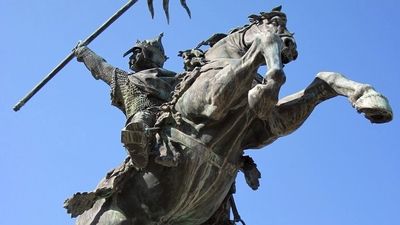
Statue of William
He ripened and became a tall, strong fellow. He had red hair. His voice was rough and gutural. William the Conqueror undoubtedly possessed considerable powers of leader and courage. He was faithful and inspired by his followers, but could also be ruthless and cruel. William de Malmesbury gives us a detailed description of the king in his "Historia Anglorum":
He was of ordinary size and corpulence, of ferocious physiognomy; His forehead was naked; With so much arm strength that it was often surprising that no one could draw his bow, which he himself could lean when his horse was galloping; It was majestic that he should be seated or standing, though the protuberance of his belly had distorted his royal person; Of excellent health, so that he was never confined with a dangerous disorder, except in the end; Thus given to the pleasures of the pursuit, that, as I said before, ejecting the inhabitants, he left a space of several miles to grow desolate that, in the freedom of other occupations, he could pursue his pleasures.
His anxiety for money is the only thing on which he can be blamed. He sought every opportunity of scraping, he did not care how; He would say and do things and, in fact, almost anything, unbecoming to such great majesty, where the hope of money attracted him. I have no excuse here to offer, unless it be, as has been said, that there must be much fear, and many fear.
William the Conqueror negotiated a marriage in 1049 with Matilda of Flanders, descendant of the old Saxon house of Wessex and daughter of Baldwin, Count of Flanders and Adela, daughter of Robert II, King of France. Tradition tells that when Duke William the Conqueror sent representatives to his father's court to request Matilda's marriage, she replied proudly informing the representative that she was too well born to consider marrying a bastard. Furious at the reception of this reply, William the Conqueror went to Bruges, where he met Matilda on his way to the church, he drew her from his horse and threw her in the street before her attendants and went away . Another version of the legend states that he went to his father's court in Lille, parading in his room and threw him to the floor in his room and hit him. On which it is said that Matilda refused to marry anyone, except William. Together, he formed an ill-assorted couple, being relatively large and strong, and rather puny. Many children, however, emerged.
The conquest of England
The Duke of Normandy visited his English cousin, Edward the Confessor, in 1051. Edward and his brother Alfred had spent much of their childhood in exile in Normandy and their mother, Emma, was a daughter of the House of Normandy. During this visit, Edward claimed to have promised his Norman cousin the crown of England, if he should die without an heir. But the real heir was Edgar the Atheling, Edward's great-nephew, the grandson of his older brother Edmund, but he was still a child and little acquainted with England, having spent his life in exile in Hungary. Other people also coveted the English throne, the main candidate being Harold, son of the mighty Godwine, Earl of Wessex whose sister Edith was married to King Edward the Confessor.
Harold unfortunately sank on the Normandy coast, where he found himself the guest of Duke William the Conqueror. It was unlikely that the Confessor would survive long and Harold was eager to return to England to convey his ambitions. However, before he allowed his guest to leave, William the Conqueror forced him to take the oath to support his claim to the crown at Edward's death. Under duress, Harold finally consented and swore an oath on holy relics.
Edward the Confessor eventually expired in January 1066 and was buried in St. Pierre's foundation at Westminster, which had been consecrated just ten days earlier. It was reported that on his deathbed he had designated Harold as his successor who was duly accepted as king by the Saxon Witangemot or the Council of Elders, who traditionally elects the next English King.
On returning to Normandy, at the reception of this disquieting news, Duke William became inflamed. He began to build a fleet for an invasion, wishing to take by force what he considered to be his rightful good. The pope himself, on account of Harold's oath of holy relics, supported William's enterprise. After Harold was crowned by Archbishop Stigand, a star was seen in the skies. Nowadays we know that it was Halley's comet, but at that time of great superstition we saw it as a portent of God's wrath over this perjured king of Harold and his disciples.
Harold then assembled the Fyrdd, the militia of the free men, in anticipation of the imminent arrival of William the Conqueror. The Due de Normadie, on the other hand, was preparing his fleet and waiting for good weather to head for England. In mid-September, Harold Hardrada, king of Norway, invaded England, accompanied by Tostig, Earl of Northumbria, the unconcerned and disgruntled brother of Harold who had already been banished and whose confessions had been confiscated.
Harold marched with his army to the north to ward off the invaders at Stamford Bridge, Yorkshire, where he won a decisive victory over the Viking army. And it was at this time that William launched his attack on England, dragging the Channel with his fleet. The news of his landing at Bulverhythe was transmitted to Harold, who replied by rushing to the south, giving his exhausted army no respite. If Harold had been able to rest and reorganize, the result of the imminent battle and the history of Angeleterre would have been different.
On October 14, the Saxon and Norman forces clashed during the Battle of Hastings. Harold took a defensive position on Senlac Ridge. The Norman army was therefore forced to attack uphill, placing them at a disadvantage. The Saxon army formed a wall of shields at the edge of the hill which repelled the repeated attacks of the Normans. A rumor arose in the ranks of the Normans that Duke William was dead, causing panic. Many Saxons pursued them to the bottom of the hill. William the Conqueror then appeared, taking the leadership over his troops. Always alive, his soldiers redoubled their confidence and attacked en masse. Harold's brothers Gyrth and Leofwine were killed on the battlefield. This battle continued for the greater part of the day, with Harold and his Saxons fighting with a strong determination for the preservation of their country. When the twilight fell on Hastings, William the Conqueror ordered his archers to shoot high in the air. One of the arrows would have struck Harold in the eyes, the blinding (This point in history is disputed). Still, Harold fell mortally wounded under the power of William.
The Saxon army, seeing that the battle was lost, began to flee the field. Harold's soldiers loyally and courageously defended their King's body at the last attack, but they eventually fell and Harold's body was mutilated by the Normans, a vindictive act that William the Conqueror punished. The battle was lost and Anglo-Saxon England died with Harold on the battlefield that day.
Harold's deeply distressed mistress, Edith Swan-neck came to William the Conqueror pleading for her lover's body by offering her gold weight in exchange, but William the Conqueror coldly refused her disoriented request. He had buried Harold in a secret place. William the Conqueror went to London, where he was crowned King of England at Westminster Abbey on Christmas Day in 1066.
On the whole, the south of England was subjected to the Normans, while the north resisted more and more. William the Conqueror replied to the rebels by submitting the English to terror. Determined to punish and crush the rebellion during his reign and to strike with fear the hearts of the English, he robbed vast tracts of Yorkshire, which suffered a great famine for nine years. He rewarded his Norman and French supporters by distributing the confiscated lands to them.
The conquest of the North
In 1068 the brothers Edwin and Morcar, two counts, rose up. They had the support of Gospatric. William the Conqueror marched through the territory of Edwin and built a castle at Warwick. Edwin and Morcar submitted, but William the Conqueror continued to York, building castles in York and Nottingham before returning to the south. On his journey to the south, William the Conqueror began to build other castles in Lincoln, Huntingdon and Cambridge and placed his supporters in charge of these new visible expressions of Norman power in England, among them William Peverel, considered his illegitimate son, in Nottingham and Henry De Beaumont in Warwick.
In 1069, Edgar Atheling revolted against the reign of William the Conqueror and attacked York. Although William returned to York and built another castle there, Edgar remained free and, in the autumn of that year, he joined forces with King Sweyn of Denmark. The Danish king brought a large fleet to England and attacked not only York, but Exeter and Shrewsbury. York was taken by the combined forces of Edgar and Sweyn. Edgar was duly proclaimed King of England by his Saxon partisans, but William the Conqueror replied with haste, ignoring a revolt in Maine. He symbolically wore his crown in the ruins of York on Christmas Day 1069, then marched to the Tees River, ravaging the surrounding countryside as he headed north. Edgar fled to Scotland, where Malcolm III., The King of the Scots was married to his sister Margaret. Waltheof, Count of Northumbria, who had joined the revolt, submitted to William, and with Gospatric were forgiven and allowed to retain their lands. But the revenge of William the Conqueror was not satiated, he then parade on the Pennines during the winter and defeated the remaining rebels at Shrewsbury before building two other castles in Chester and Stafford.
In 1070, the heroic Hereward the Wake rose in a rebellion against the Norman domination centered on the island of Ely. William the Conqueror then led an army to Ely, where Hereward, joined by a small army led by Morcar, the former Saxon Count of Northumbria, took a desperate position. Finally, the Normans bribed Abbé Thurstan d'Ely to reveal a safe route through the marshes, which resulted in the capture of Ely. Morcar was captured and imprisoned, but Hereward managed to escape into the wild valley to continue his resistance.
William the Conqueror had rules which in some respects were very modern but also cruel, but ultimately his methods produced the desired results and he extinguished the fires of the opposition as soon as they presented themselves. Many castles and guards were built across the country to enforce his rule, originally wooden towers or clods of earth (more than 80 castles were created during the reign, including the White Tower) . The dominant shadow of the White Tower appeared threateningly on medieval London, a visible expression of Norman rule.
Anglo-Saxon England was radically modified following the Norman conquest, it changed the whole way of life established in the country for centuries. His laws, the aristocracy and the church were modified and he introduced the French feudal system. The Anglo-Saxon language has been replaced by Norman French as a language of the upper classes, and modern English is the natural consequence of these two languages.
The feudal Norman system that William introduced into England was a complicated hierarchical structure at the top of which the king was. The lords held their lands of the king in exchange for the homage and the military assistance that were brought to them in case of need. The conversion of New Woods into a royal hunting ground of William the Conqueror saw the introduction of severe forestry laws, which provoked great resentment among the Anglo-Saxons. William the Conqueror changed the laws of England and inflicted exemplary punishments on the delinquents. Murder became a formally punishable offense in England and slavery was abolished.
The Tapestry of Bayeux
The half-brother of the king, Odo, bishop of Bayeux, commissioned a tapestry to commemorate his brother's victory in 1078. It represents a series of scenes leading to the conquest of England. In common with other embroidered hangings from the early medieval period, this piece is classically called "tapestry", although it is not a real tapestry in which the design is woven into the fabric; it is actually an embroidery. Titles are included in many scenes to indicate the names of people and places or to briefly explain the event represented.
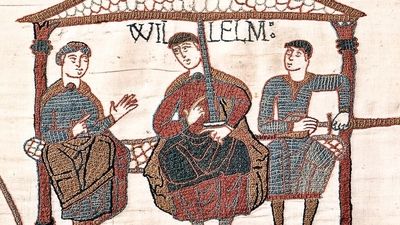
Tapisserie de Bayeux
The Domesday Book
In December 1085, William the Conqueror decided to investigate the extent of his domains to maximize taxation. All the Norman lords and barons whom King William granted in England were ordered to collect information on their estates, which were to be sent to the councilors of William the Conqueror. Officials were then dispatched to the 34 counties that then formed the kingdom of England to check the information and attempt to get more. The officials were instructed to ask specific questions about the location of property and land, their belongings, occupations, the size of the herds kept there, and so on.
For each individual landed property the answers were controversial in order to discover also how much land was really worth in the reign of Edward the Confessor, before the conquest. The proprietors testified under oath of the members of the royal authority, or of the barons. The work was made more difficult by the fact that most of the population of England spoke English Anglo-Saxon or ancient at the time while the officials of William the Conqueror spoke only French-Norman. This unique survey was known in history as the "Domesday Book". The book Domesday has reached us, it is at the "Public Record Office of London" and is an extraordinary document for its time.
The death of William the Conqueror
The last years of the life of William the Conqueror were devoted to fighting in Normandy. Among those with whom he confronted himself, there was Robert, his eldest rebel son. In a battle in January 1079 Robert wounded William the Conqueror, ceasing his attack only when he recognized the voice of his father. Humiliated, King William cursed his son, then raised the siege and returned to Rouen.
At Easter 1080 a reconciliation between father and son was proposed by Queen Matilda. The family was gathered in Breteuil, northern France, for celebrations marking the betrothal of William the Conqueror and Matilda, the 14-year-old daughter, Adela, to Stephen, the Earl of Blois. Matilda then encouraged William the Conqueror to make peace with his distant half-brother, Odo, the bishop of Bayeux.
When Matilda fell seriously ill, William the Conqueror rushed to Normandy to be at his bedside. He wrote to Robert at the Château Gerberol, asking him to come immediately to Rouen. Matilda died in Caen in November 1083 at the beginning of her fifties, following a persistent disease. Her husband was at his bedside for the last confession. Following her will, she left large amounts of money to the poor and her royal scepter and her crown to the abbey of Sainte-Trinité. She was buried in the choir of the Holy Trinity, the Abbaye aux Dames, its foundation, in Caen, in Normandy.
On September 9, 1087, while traversing the burning ruins of the city of Mantes, in what must have appeared to him as an act of divine retribution, William the Conqueror was ejected from his horse when he trampled burning ashes and underwent a severe abdominal injury. The king, fifty-nine years of age and mortally wounded, was taken to the convent of Saint-Gervais in Rouen, the Norman capital. There he summoned his younger sons, William and Henry, on his deathbed. Robert had remained at the court of France. William the Conqueror confessed his sins and asked for forgiveness. His treasure was distributed to the churches and the poor, "that what I have accumulated through evil deeds may be assigned to the holy uses of good men."
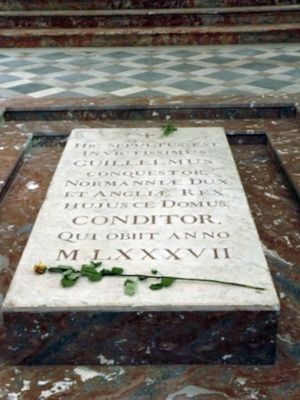
Tomb of William
England was bequeathed to her second surviving son and favorite, William Rufus and, in spite of his bitter differences with Robert, he ceded Normandy to him. For Henry, the youngest son, later destined to inherit all his territories, he left 5,000 pounds of silver. He would have ruminated and repented of his many sins, transgressions and cruelties at the end of his life. He tried to cleanse his consciousness before preparing to meet his creator and to fear for his immortal soul. He ordered that the treasure he possessed in Rouen be given to the Church and to the poor and forgive his enemies. William the Conqueror died on September 9, 1087, after reigning over England for 21 years.
He was buried at the monastery of St Stephen in Caen, in Normandy, an abbey which he had previously founded as an act of repentance for his consanguineous marriage with Matilda of Flanders. The body had to be broken because it could not enter the sepulcher, cut too short by stone cutters. Moreover, the burial ceremony was interrupted by a dispossessed knight. A stone slab with a Latin inscription in the abbey church of Caen still marks the burial place of the first Norman king of England. His grave has since been desecrated twice, once during the French wars of religion (his bones were scattered throughout Caen) and a second during the tumultuous events of the French Revolution (the Tomb of the Conqueror was again stripped) .






